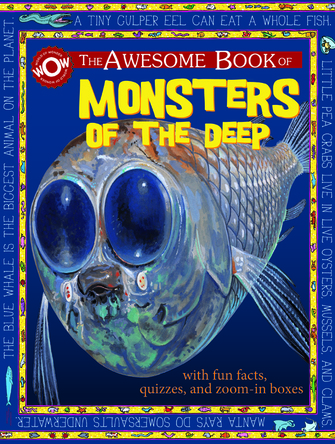Extrait du livre Monsters of the Deep
Get ready to hear your kids say, “Wow! That’s awesome!” as they dive into this fun, informative, question-answering series of books! Students—and teachers and parents—will learn things about the world around them that they never knew before! This approach to education seeks to promote an interest in learning by answering questions kids have always wondered about. When books answer questions that kids already want to know the answers to, kids love to read those books, fostering a love for reading and learning, the true keys to lifelong education. Colorful graphics are labeled and explained to connect with visual learners, while in-depth explanations of each subject will connect with those who prefer reading or listening as their learning style. This educational series makes learning fun through many levels of interaction. The in-depth information combined with fantastic illustrations promote learning and retention, while question and answer boxes reinforce the subject matter to promote higher order thinking. Teachers and parents love this series because it engages young people, sparking an interest and desire in learning. It doesn’t feel like work to learn about a new subject with books this interactive and interesting. This set of books will be an addition to your home or classroom library that everyone will enjoy. And, before you know it, you, too, will be saying, “Wow! That’s awesome!” “People cannot learn by having information pressed into their brains. Knowledge has to be sucked into the brain, not pushed in. First, one must create a state of mind that craves knowledge, interest, and wonder. You can teach only by creating an urge to know.” - Victor Weisskopf
Introduction Some ocean giants, such and count! as baleen whales, are monstrous in size, but are gentle creatures. Others, however, are killers. Man-eating sharks and poisonous jellyfish that can kill a person in under a minute roam the world’s seas. Some of the fiercest deep-sea monsters are tiny. They glow in the dark, lure victims to their death, and have scary teeth—nature’s way of equipping them for survival in the alien world of the deep sea. And there may be far more monsters in the ocean than we think—many sightings of odd creatures remain a mystery. Q: Why watch out for these boxes? A: They give answers to the monster questions you always wanted to ask. Bits and Pieces Look out for these boxes to take a closer look at the features of certain animals or places. Awesome Facts Watch out for these diamonds to learn more about the truly weird and wonderful facts about amazing creatures of the deep-sea and their murky world.
The hagfish can tie itself in knots and eats its food from the inside out Ocean Layers The ocean can be divided into layers according to the depth of the water and the amount of sunlight received. The real giants, such as whales, live in the upper layers, while the more bizarre monsters—at least to our eyes—live in the depths. The surface zone is the layer near the surface of the open ocean. Here, the sun warms the water, and sunlight enables phytoplankton (tiny plant organisms) to grow. This is the basic food on which most animals in the sea depend. The world’s oceans cover nearly three-quarters of the Earth’s surface: of the 200 million square miles (510 million square kilometers) of Earth’s surface, about 140 million square miles (360 million square kilometers) are oceans and seas. Nearly all this water is over 650 feet (200 meters) deep. The twilight zone is the midwater layer between 650 and 3,280 feet (200 and 1,000 meters) deep, reached by little sunlight. Many animals here are red; because water absorbs the color red, the creatures are nearly invisible. The deep-water zone is where almost no sunlight penetrates. There are no plants in these murky depths, so deep-sea creatures have to eat what they can get. The slithery hagfish (above) feeds on the tissues of dead animals. Most marine life is concentrated in the top layer of the ocean. Giant baleen whales skim the surface, and high-speed tuna chase small fish. Fish in mid-waters carry their own lights— for camouflage, to startle predators, or as a lure to catch prey. Many make vertical journeys every night to feed in the surface layers. Creatures in the dark depths either intercept prey by attracting it with luminous bait, or they scavenge on dead sea-creature bodies raining down from the surface.
There are animals the size of small whales swimming around that no human has ever seen. Discovering New Worlds Most of the oceans are unexplored. It has been said that there are more footsteps on the moon than on the bottom of the deep sea. The oceans are so vast that even big marine creatures have been able to avoid being seen by people. Many of the “new” sea animals are now being discovered. Big mouth In 1976, a megamouth shark 18 feet (5.5 meters) long was caught in the Pacific Ocean. Until that day, nobody knew it even existed, and only a few have been found since. It feeds on deep-sea shrimp by filtering them from midwater areas. At the bottom of the deep sea is a recently discovered world that centers not on sunlight, but on underwater hot springs heated by the Earth’s molten core. Sulfur in the water feeds bacteria that, in turn, fuel a whole community of odd animals, such as 6.5-foot (2-meter) long red worms and giant clams. Awesome Facts While there are 20 million light-sensitive rods in the whole of the human eye, the rattail’s eye has 20 million of them in an area the size of this “o.” The tripod fish lives on the bottom of the deep sea. It has long, feeler-like pectoral fins that it appears to use as landing gear. It springs slowly across the seabed like a grasshopper. The rattail, or grenadier, is the most common of all deep-sea bottom-dwelling fish. It varies in length from 8 to 40 inches (20 to 100 centimeters), and it grunts using its swim bladder. Its large eyes are extremely sensitive.
The blue whale can cruise underwater at a speedy 23 miles (37 kilometers) per hour. The Big Blue Baleen whales range in size from the colossal 108-foot (33-meter) long blue whale to the 20-foot (6-meter) long pygmy right whale. Slow-swimming right and bowhead whales skim the surface, gray whales often feed on the seabed, and fast-swimming fin whales take gulps of krill, fish, and seawater. The blue whale is the world’s largest living animal. It also has the world’s loudest voice—a 30-second-long low-frequency moan that can be heard hundreds of miles across the ocean. The blue whale is found in all of the oceans and migrates between breeding sites in tropical seas and feeding grounds nearer the poles. Awesome Facts The blue whale almost became extinct because of whaling, but a ban has meant populations are recovering. There are now between 5,000 and 10,000 blue whales worldwide. Filter Feeding The right whale is recognized by the white crusty “callosities” on its head. Like all baleen whales, it is a filter feeder. It skims surface waters, filtering out krill and copepods (tiny shellfish) with long, comblike baleen plates in its upper jaw. The plates are modified teeth. If prey is densely concentrated, several whales will feed side-by-side.
The great white shark is the only shark that holds its head above water to see what’s happening on the surface. Killers ! Sharks are the most feared animals in the sea. They have excellent hearing and can even detect the electronic field surrounding other creatures. Although attacks are rare, several kinds of shark will eat people. The tiger shark, up to 18 feet (5.5 meters) long, eats just about anything—including rubber tires! Q: Why do some sharks prod their prey? A: The oceanic whitetip shark will eat what it can get. It scours the open ocean for food and always turns up at mid-ocean disasters. Unlike other sharks, which circle a victim before attacking, the oceanic whitetip rushes in, bumps its target to assess its food value, and then takes a bite! Awesome Facts The bull shark is thought to be one of the world’s most dangerous sharks. It attacks in rivers and lakes, where it goes to give birth. The great white shark is a monster man-eater—the largest predatory fish in the sea, and the number one people killer. It grows up to 22 feet (6.6 meters) long. It prefers to eat seals, but swimmers or surfers near seal breeding colonies are at risk of being attacked, mostly as a case of mistaken identity. How many teeth can you count? When sharks get very excited by a sudden glut of food, their sensory systems become overloaded and they indulge in a wild feeding session, known as a “feeding frenzy.” Sharks generally tend to avoid each other, but larger sharks may show their strength by slashing at smaller sharks during a frenzy.



























